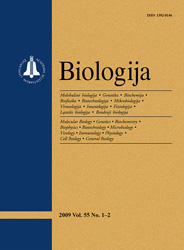Biologija / Biology
 ISSN 1392-0146 ISSN 2029-0578 (online) |
2006 m. Nr. 3 Comparison of different IAA–ABP complexes formed
in kidney bean cell chloroplasts and mitochondria
The molecular mechanism of phytohormone indole-3-acetic acid (IAA) action was investigated. The possibility of the formation of specifically bound IAA–ABP (auxin-binding protein) complexes in organelles (chloroplasts and mitochondria) and the importance of intactness and functionality of the organelles in the formation of these complexes have been revealed. Our results show that two different IAA–ABP complexes may be formed in the intact chloroplasts (optimal pH 5.5 and 7.5) and one (optimal pH 7.0) in mitochondria. IAA–ABP complexes differ in respect of their main characteristics (the content of specifically bound IAA, specificity, number of IAA binding sites (n), dissociation constant (KD) and ligand effectiveness). They also differ from IAA–ABP complexes formed in the plasmalemma at pH 5.5 (having the type of structure of the auxin-binding site characteristic of the auxin receptor mediating plant growth by elongation in monocot and dicot plants) and from the second IAA–ABP complex (optimal pH 7.5) formed in this membrane as well as from both IAA–ABP complexes formed in the cytosol at pH 7.8 of kidney bean cells [11]. We suppose that the role of separate IAA–ABP complexes in IAA-dependent response(s) of the cell may be different.
Keywords: IAA–ABP complexes, chloroplasts, mitochondria, plasmalemma, kidney bean |
Issues:
2011 - Vol.57 No. 1, No. 2, No. 3 2010 - Vol.56 No. 1-4 2009 - Vol.55 No. 1-2, No. 3-4 2008 - Vol.54 No. 1, No. 2, No. 3, No. 4 2007 - Vol.53 No. 1, No. 2, No. 3, No. 4 2006 No. 1, No. 2, No. 3, No. 4 2005 No. 1, No. 2, No. 3, No. 4 2004 No. 1, No. 2, No. 3, No. 4 2003 No. 1, No. 2, No. 3, No. 4 2002 No. 1, No. 2, No. 3, No. 4 2001 No. 1, No. 2, No. 3, No. 4 |